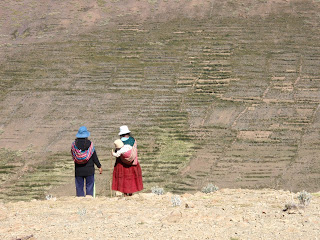As I said in the last entry, we are getting to see all kinds of Incan and pre-Incan ruins and learn about these ancient cultures. We recently spent three days walking and camping on Isla del Sol (Island of the Sun), which is lies on the enormous Lago Titicaca (Lake Titicaca). Lago Titicaca is the largest lake in South America, and at over 3800 meters it is one of the highest navigable lakes in the world. It lies along the borders of both Peru and Bolivia and is so vast that looking out over it you could imagine you're at the ocean.
 The lake held much significance for the Incan and pre-Incan Aymara and Quechua cultures, whose descendents still live in the region. The name Titicaca comes from Aymara and Quechua words meaning ¨Puma Rock¨, perhaps because the island´s shape resembles a puma. Sacrifices to the lake were often made to ensure safety in sailing and good harvests. Isla del Sol is also very culturally significant. The Incans believed that it is the birthplace of their Sun God, whom they highly worshipped, and indigenous people today still consider the island to be a sacred place.
The lake held much significance for the Incan and pre-Incan Aymara and Quechua cultures, whose descendents still live in the region. The name Titicaca comes from Aymara and Quechua words meaning ¨Puma Rock¨, perhaps because the island´s shape resembles a puma. Sacrifices to the lake were often made to ensure safety in sailing and good harvests. Isla del Sol is also very culturally significant. The Incans believed that it is the birthplace of their Sun God, whom they highly worshipped, and indigenous people today still consider the island to be a sacred place.
 The lake held much significance for the Incan and pre-Incan Aymara and Quechua cultures, whose descendents still live in the region. The name Titicaca comes from Aymara and Quechua words meaning ¨Puma Rock¨, perhaps because the island´s shape resembles a puma. Sacrifices to the lake were often made to ensure safety in sailing and good harvests. Isla del Sol is also very culturally significant. The Incans believed that it is the birthplace of their Sun God, whom they highly worshipped, and indigenous people today still consider the island to be a sacred place.
The lake held much significance for the Incan and pre-Incan Aymara and Quechua cultures, whose descendents still live in the region. The name Titicaca comes from Aymara and Quechua words meaning ¨Puma Rock¨, perhaps because the island´s shape resembles a puma. Sacrifices to the lake were often made to ensure safety in sailing and good harvests. Isla del Sol is also very culturally significant. The Incans believed that it is the birthplace of their Sun God, whom they highly worshipped, and indigenous people today still consider the island to be a sacred place. One can find many ruins of ancient structures on the island. This site, called Chincana, was built by pre-Incan people and is also called the Laberinto, or Labyrinth, for its complex network of rooms.
 The Ruta Sagrada, or Sacred Route, follows a high ridge from one end of the island to the other and leads you past ruins and beautiful views of the island and Lago Titicaca. It was built hundreds of years ago and is still maintained by the islands inhabitants.
The Ruta Sagrada, or Sacred Route, follows a high ridge from one end of the island to the other and leads you past ruins and beautiful views of the island and Lago Titicaca. It was built hundreds of years ago and is still maintained by the islands inhabitants. The people living on Isla del Sol are very friendly and we enjoyed chatting with them and sharing greetings as we passed each other on the island's footpaths. Most of them speak Spanish, but occasionally we had the treat of overhearing the native Quechua language being spoken as well! There are no vehicles on the island so walking is the main means of transportation. People make their living from farming, fishing, and the growing tourism to the island. All over the island are terraces where wheat, oats, corn, fava beans and other crops are grown.
The people living on Isla del Sol are very friendly and we enjoyed chatting with them and sharing greetings as we passed each other on the island's footpaths. Most of them speak Spanish, but occasionally we had the treat of overhearing the native Quechua language being spoken as well! There are no vehicles on the island so walking is the main means of transportation. People make their living from farming, fishing, and the growing tourism to the island. All over the island are terraces where wheat, oats, corn, fava beans and other crops are grown.  They also raise livestock, including sheep, pigs, llamas and mules, and we passed many people herding their animals to and from grazing lands.
They also raise livestock, including sheep, pigs, llamas and mules, and we passed many people herding their animals to and from grazing lands. I have to say that Isla del Sol is one of my favorite spots in Bolivia. The incredible landscape, the rich traditional culture and friendly people made it a very memorable experience!
I have to say that Isla del Sol is one of my favorite spots in Bolivia. The incredible landscape, the rich traditional culture and friendly people made it a very memorable experience!
No comments:
Post a Comment